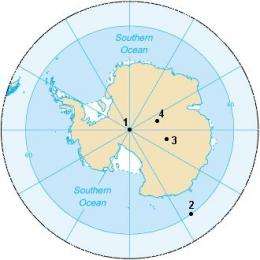January 2, 2012 report
Two New Zealand scientists to travel to Antarctica to measure magnetic South Pole

(PhysOrg.com) -- While the rest of the world gets on with meeting the New Year head on, two research scientists from New Zealand are traveling to the Antarctic to take measurements of the magnet South Pole. Such periodic measurements are necessary geo-scientists say, because the magnetic poles keep moving around. The south magnetic pole, for example is slowly moving north toward Australia at almost ten miles per year; this matters because very accurate ground measurements are necessary to keep satellites properly calibrated, ensuring such things as GPS coordinates are accurate.
The magnetic poles move, as do other parts of the Earth’s surface, because the outer core inside the planet is made of molten metal. As the Earth moves through space, spinning and circling the sun, there is some jostling that goes on, resulting in some shifting. And unfortunately, it doesn’t do so in a regular predictable fashion, which means changes to the surface of the Earth must be constantly monitored all over the planet. For reasons that aren’t exactly clear, New Zealand has been charged with monitoring the south magnetic pole, and has been doing so by traveling there every five years since the 1950’s.
This latest expedition, made up of just two guys, Stewart Bennie and Tony Hurst, will travel first to a particularly barren locale known as Lake Vanda in one of Antarctica’s dry valley areas. After that, they will travel to a site near the shelter constructed and used by the infamous polar explorer Robert Scott and his team before they were lost trying to return home back in 1912-13 as part of the Terra-Nova Expedition.
To take their measurements, the team will make note of physical landscape features, then will use a tool known as a magnetic theodolite to measure magnetic field angles relative to the ground. At the south magnetic pole, such fields should be 90 degrees relative to the horizon. They will also be using instruments that allow them to measure the strength of the magnetic field, which will be useful, because scientists have found that the magnetic fields have been diminishing over the past couple of hundred years, a sign perhaps that a “flip” is in the making over the next thousand years or so.
To take into account the wobbling that occurs with magnetic fields, the two will take many such measurements over the course of a day to make sure that what they bring back to report, is truly accurate.
More information:
via Nature
© 2011 PhysOrg.com




















